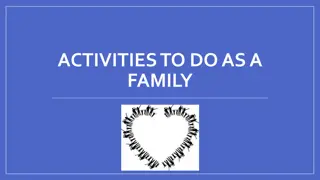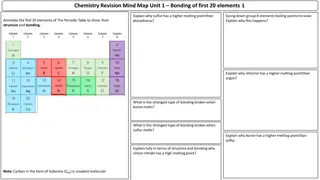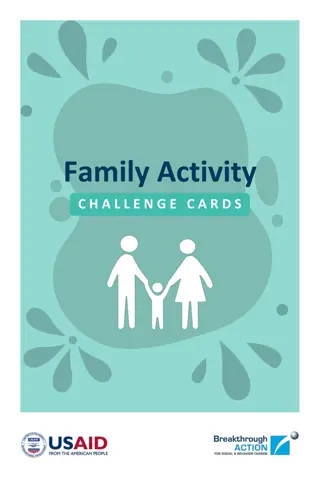Interactive Family Activities for Bonding and Fun
Engage in a variety of interactive and engaging family activities to foster connection and enjoyment. From emoji charades to storytelling relays, photo scavenger hunts to spaghetti challenges, these activities offer opportunities for creativity, teamwork, and laughter. Enhance communication skills, build empathy, and strengthen relationships through these dynamic exercises. Let the fun begin with these versatile icebreakers and team-building games!
Download Presentation

Please find below an Image/Link to download the presentation.
The content on the website is provided AS IS for your information and personal use only. It may not be sold, licensed, or shared on other websites without obtaining consent from the author.If you encounter any issues during the download, it is possible that the publisher has removed the file from their server.
You are allowed to download the files provided on this website for personal or commercial use, subject to the condition that they are used lawfully. All files are the property of their respective owners.
The content on the website is provided AS IS for your information and personal use only. It may not be sold, licensed, or shared on other websites without obtaining consent from the author.
E N D
Presentation Transcript
Activity Bank Index Icebreakers pg. 2 Emoji charades Family Space pg. 2 Storytelling relay Family Space pg. 2 Photo scavenger hunt Family Space pg. 3 Spaghetti challenge Family Space Family Space Human lineup pg. 3 Family Space Freeze dance pg. 3 Communication Games Chemistry Game (Session 1) pg. 4 Family Space Family Space Empathways: Challenge Card Edition (Session 2) pg. 5 Family Space Compliment Circle pg. 5 Family Space Word Association Game pg. 6 Question Jar pg. 7 Family Space Exercises Family Space Communication Skills Building Part 1 pg. 8 Family Space Communication Skills Building Part 2 pg. 10 Safe Schools Family Space Multi-Stakeholder Forum Empathy Building pg. 12 Envisioning your ideal relationship pg. 13 Family Space Values Clarification pg. 14 Safe Schools Family Space Multi-Stakeholder Forum Opportunity Mapping pg. 16 Multi-Stakeholder Forum Storytelling pg. 17 Multi-Stakeholder Forum Parent/Caregiver Breakout Session: Skills Building Psychologist-led discussion questions Gender Box pg. 18 Safe Schools Family Space Multi-Stakeholder Forum Safe Schools Family Space Multi-Stakeholder Forum Gender Stereotypes pg. 20 Psychologist-led discussion questions pg. 22 Family Space Fill-in-the-Blank Letter Writing pg. 23 Family Space VYA Activities Dreamboard pg. 24 Family Space Timeline pg. 25 Family Space Video: AMAZE Gender Stereotypes Mini Art Show pg. 26 Family Space Bucket List pg. 26 Family Space Family Space Journaling pg. 27
Activity Bank Icebreakers Icebreakers should be fun, energizing, engaging, and involve all participants. These Icebreakers are merely suggestions and can be substituted with other activities that make more sense for your audiences. For the proposed icebreakers, some preparation and materials are required. ICEBREAKER: Emoji charades For use in the following interventions: Family Space Instructions Play charades where players act out emojis without speaking and relying solely on gestures, facial expressions and body movements to communicate with their team. ICEBREAKER: Storytelling relay For use in the following interventions: Family Space Instructions Participants collaboratively build a story by each contributing one line. Sit in a circle, start with one participant, and keep going until everyone has contributed one sentence. See where you end up! ICEBREAKER: Photo scavenger hunt For use in the following interventions: Family Space Instructions Send families on a rapid scavenger hunt where they have to take pictures of certain things. For example, take a selfie looking up at a tree, or take a picture at the corner store. 2
Activity Bank Icebreakers ICEBREAKER: Spaghetti challenge For use in the following interventions: Family Space Instructions Provide small groups of 4-6 people with the same amount of uncooked spaghetti (can be substituted with sticks, or anything long and thin that can easily break), tape, marshmallows (can be substituted with candied ginger, tapioca pearls, mochi, dried fruit) and a few pieces of string. Give them 5-10 minutes to build the tallest and most stable free-standing tower using only the provided materials. ICEBREAKER: Human lineup For use in the following interventions: Family Space Instructions Without talking, participants must arrange themselves in a specific order based on a particular criterion, such as shoe size, birthday, height, size of favorite animal, etc. The criteria can be silly and fun! ICEBREAKER: Freeze dance For use in the following interventions: Family Space Instructions Play music and instruct the participants to pass the ball around while dancing. When the music stops, the person holding the ball has to answer a question that is listed on the ball. This requires the facilitator to prepare a ball that has questions on it. 3
Activity Bank Communication Games Chemistry Games, the Interactive Video Screening, and Empathways, the Communication Games can be conducted in different sequences. COMMUNICATION GAMES: Chemistry Game (Session 1) For use in the following interventions: Family Space Instructions Separate participants into pairs (father-child, mother-child) Ask questions to test the chemistry or how well the pair knows each other. On the count of three, participants show their answers. There may be similar or different answers, and that s okay. Once all questions have been asked, ask 1-2 pairs of families to share about their results. How similar or different were the results? What did they learn? What surprised them? Distribute writing tool and pieces of paper upon which to write. Materials List of questions (see suggestions below) Pieces of paper or a whiteboard or chalkboard on which participants can write their answers Writing tool for each participant Adaptation Guidance If playing this game among a low-literacy audience, have each pair just shout the answer on the count of three rather than writing down the answers. The questions can be customized to your context, yet they should remain relatively easy to answer in a few seconds in 1-2 words. Here are some examples below: What is the child's favorite color? What are the names of the child's close friends? What is mom/dad's favorite food? Where was the child born? Who always wakes up early? What is the child's hobby? What is the child's least favorite food? What is your child's least favorite food? What are your hobbies? When is the father/mother's date of birth? What is the child's favorite food? What does the child like to do on holidays? How old is the father/mother? What is the child's date of birth? 4 What is your favorite thing to do?
Activity Bank Communication Games COMMUNICATION GAMES: Empathways: Challenge Card Edition (Session 2) Instructions Ask families to sit face-to-face Distribute one deck of the Empathways cards to each family Read the instructions listed in the card deck Ask families to read the pledge to each other before starting Participants take turns answering the same question (1-2 minutes per person) until they finish the card deck or the time runs out. Explain that there are activity challenge cards that they must complete when those cards are drawn. Materials One set of Empathways cards per family. Adaptation Guidance The challenge cards can be customized to your specific setting. While there may be more questions than can be answered in the allotted time, you can shorten the card deck and prioritize which questions should be answered. COMMUNICATION GAMES: Compliment Circle Instructions Give each family a piece of flipchart paper and some Post-it notes. Instruct caregivers and VYAs to take turns giving compliments to each other. Write each compliment down and post it on the flip chart paper so that participants can keep a visual record of what they really like about each other. Encourage participants to not talk about physical appearance. Keep the positivity flowing! Do this for about 15 minutes. Then ask families to share back. What did this exercise make them feel? What did they learn about each other? What surprised them? Materials Flipchart paper Post-it notes Pens or markers Adaptation Guidance This can be used during any class after the first and second classes. 5
Activity Bank Communication Games COMMUNICATION GAMES: Word Association Game Instructions The goal of this game is to surface implicit gendered expectations and associations that we have so that they participants can increase awareness of them. Start with a word or phrase that is related to gender and go around the circle, with each person saying the first word that comes to mind. See where the chain of words takes the group. Repeat this a few times. Once the game is complete, there is an option to break out into discussion groups (one group of adults, one group of adolescents) to discuss any surprises they heard during the game, what they learned, or felt. Materials Pre-selected list of gender-focused words or norms to use as the facilitator Adaptation Guidance This can be used during any class after the first and second classes. Select gender norms, words or phrases that are relevant to your context: Words Norms Boys Boys shouldn t cry Girls Girls shouldn t cry Strong Girls need more protection than boys Pretty Men are providers Feminine Women are caretakers Masculine Women are providers Girls should be thin and pretty Boys shouldn t be tall and strong 6
Activity Bank Communication Games COMMUNICATION GAMES: Question Jar Instructions Provide each family with a jar or bowl that is pre-filled with questions. Family members take turns drawing questions from the bowl and answering honestly. Remind families to be respectful and not be judgemental. Materials One jar, bowl or container per family pre-filled with questions Adaptation Guidance This can be used during any class after the first and second classes. Here are some sample questions that aim to spark conversation about gender norms. Mix these in with other, non-gender-related questions. Consult this website for additional ideas and questions. https://happyyouhappyfamily.com/questions-for- kids/?fbclid=IwAR14Odtl9WobGGQB-shEZxdcw5IoPnGIGHeKfzpDyevrGS0wwWmuh6RscCc Sample questions that can be customized: What do you find difficult about being a boy or girl (or a man or a woman)? What messages do you think media (TV, movies, advertising) convey about how boys and girls should be? How do those messages make you feel? Have you ever felt pressured to be more like a boy or more like a girl? What happened and how did that make you feel? How can I help you to be more YOU? Can you think of examples of people who challenge or defy traditional roles for boys and girls? What do you think about that person? Do you think it is admirable, foolhardy? 7
Activity Bank Exercises Chemistry Games, the Interactive Video Screening, and Empathways, the Communication Games can be conducted in different sequences. EXERCISE: Communication Skills Building Part 1 For use in the following interventions: Family Space Goals Build parents' and caregivers knowledge and skills to communicate with their children openly, effectively, and without judgment Reference This activity is adapted from the Go Girls! Communication Resource Preparation Facilitators review positive and negative communication strategies on pages 23-28 of the Go Girls! Communication Resource Instructions Distribute Active Communication handouts to each participant. Ask participants to read the definitions and examples out loud Read out the following scenarios and ask participants to guess which one uses an active skill (understanding, listening, questioning) Scenario 1: [NAME OF GIRL] tells her mother that she is struggling in one of their classes. Her mother stops what she s doing, turns to her daughter, and asks What subject was that in? and then asks Do you have any idea how it can go better next time? [Active questioning] Scenario 2: [NAME OF GIRL] tells her mother that a teacher told her she did very well in class today. Her mother says That s good and then continues with her work. [None] Scenario 3: [NAME OF BOY] tells his father that he wants to be a teacher when he is older but he is feeling unsure about how he is doing in school. His father says I think your idea to be a teacher is very good and I am proud of you. It seems you are finding schoolwork difficult, though. What is it exactly that is hard for you? How can our family help you? [Active listening] Activity continue 8
Activity Bank Exercises EXERCISE: Communication Skills Building Part 1 Instructions Scenario 4: [NAME OF GIRL] tells her mother that a boy in the village keeps teasing her. [NAME OF GIRL] starts to cry. [NAME OF GIRL] s mother says I know how you feel, when I was young other boys used to tease me too and it was very hard. How does it make you feel? She adds that [NAME OF GIRL] can always come to tell her if anything else bad happens. [Active Understanding] Note to Facilitator: Reinforce with the participants that all three kinds of communication: Active Listening, Active Questioning and Active Understanding are important and support each other. Stimulate a discussion by asking participants: a. Do you currently use any of the three skills (active listening, questioning, and understanding) with young people? If you used these skills to communicate with young people, how do you think it helped? Can you think of a time when using these skills would be challenging? Why? b. c. Summarize their responses and add the following points: Active understanding is helpful because when you accept your young person s ideas and feelings it will increase the chance of him/her talking with you more. Active listening is helpful because when you pay attention to what the young person is saying, they will feel important and know that you are there to help. It will also help you and the young person understand each other better and, if there is a problem, begin to find solutions. Active questioning is helpful because it lets the young person know you want to know more about them. This will motivate them to come to you again. Option to conduct role-play activities in Communication Skills Building Part 2. Materials Print-out of Active Communication Handout (adapted from Go Girls!, p. 32). Adaptation Guidance Pick names of characters that make sense in your context. Prep: Facilitators review positive and negative communication strategies on pages 23-28 of the Go Girls! Communication Resource 9
Activity Bank Exercises EXERCISE: Communication Skills Building Part 2 For use in the following interventions: Family Space Goals Build parents' and caregivers knowledge and skills to communicate with their children openly, effectively, and without judgment Reference This activity is adapted from the Go Girls! Communication Resource Instructions Practice what was learned in Communication Skills Building Part 1. Divide the participants into groups of 2-4 people and assign each group (a) one of the three communication skills to practice (active understanding, listening, and questioning) and (b) one scenario. GROUP 1 Active listening Your child tells you they are being bullied in school GROUP 2 Active understanding Your child tells you they want to be a make-up artist. GROUP 3 Active questioning Over the last several weeks your child has stopped showing interest in the activities they used to enjoy and has started sleeping for long hours, spending most of their time in their room or on the couch at home. It s clear something is wrong and you re starting to worry about them. Ask each group to create two role-plays of a conversation between an adult and a young person. The groups will demonstrate what happens when someone does not use their communication skills versus what happens when someone does use communication skills. Each role-play will be 3 minutes in length and will be performed in front of the whole group. Every person in the group should participate in at least one of the role play scenarios. Role-play 1: The actors will demonstrate people who are not using the communication skill they were assigned. Instead, they will show the opposite (for example, if their group is given Active Listening then they will do a role-play where someone is not listening actively). Role-play 2: The actors will demonstrate people who are using the communication skill they were assigned. Activity continue 10
Activity Bank Exercises EXERCISE: Communication Skills Building Part 2 Instructions While the groups are preparing, check in with each group to answer any questions and to clarify the key points under each skill. Ask each group to perform their two role-plays. After everyone has performed their role-plays, stimulate a discussion by asking the following questions: a. b. c. What were the main differences between the two role-plays? Did the communication skills help the adult and child communicate with each other? Which of the communication skills do you think would be the easiest for you to use with your young person and which would be the hardest? Why? Materials Print-out of Active Communication Handout (adapted from Go Girls!, p. 32). 11
Activity Bank Exercises EXERCISE: Empathy Building For use in the following interventions: Family Space Safe Schools Multi-Stakeholder Forum Goals Identify and empathize with common challenges that VYAs experience Instructions Brainstorm Distribute Post-it notes to each participant Give participants 5-10 minutes to brainstorm as many answers as they can to this question: What are the biggest challenges 10-14-year-olds face? Write one challenge per Post-it. Encourage participants to write as many post-its as they can. Cluster Ask for a volunteer to share what they wrote and post it on the wall or flip-chart paper. Ask other participants if they have something similar to add. Discuss Ask the group to choose which challenge resonated most with them. Ask a few probing questions as you see fit. Try to get them to think more about the differences: How does your experience of adolescence as a boy or girl compare with the experience of adolescent boys and girls today? Is it easier or more difficult today? Why are there different expectations for boys and girls? How do you think they will help boys and girls in the future? Or harm boys and girls in the future? What does a typical day in the life of an adolescent girl look like compared to that of an adolescent boy? What expectations do you, as parents, and as professionals, have for adolescent girls and boys? If you had to switch places with one of your children of the opposite gender, what do you think would be the most difficult thing to face in terms of gender-specific experiences? Materials Flipchart paper Post-it notes Markers Adaptation Guidance VYAs can be referred to as students or children, depending on the audience. If using this activity for the Multi-Stakeholder Forum, appeal to Forum members as parents or guardians as a way to get them to empathize. 12
Activity Bank Exercises EXERCISE: Envisioning your ideal relationship For use in the following interventions: Family Space Goals Help parents envision and articulate their ideal relationship with their child so that they can work towards achieving that vision. Prepare Facilitators review positive and negative communication strategies on pages 23-28 of the Go Girls! Communication Resource Instructions Brainstorm Share paper and pens or pencils with each participant. Give participants 5-10 minutes to write about what the ideal relationship with their child would look like. Participants do not need to share this with anyone. Question prompts: How would you feel when you re around each other? How would you want your child to feel? How much time would you spend together? What would you do during that time? What would you talk about? What would you know about each other? How would you support or care for one another? Encourage participants to think beyond obedience. This isn t about just getting their children to listen and obey. 5 minutes: Ask if anyone would like to share something they wrote down or thought about during the exercise. Participants do not need to share if they don t want to. Materials A piece of paper for each participant Pencils, pens or markers for each participant Adaptation Guidance For low-literacy audiences, have participants draw about their ideal relationship rather than write about it. 13
Activity Bank Exercises EXERCISE: Values Clarification For use in the following interventions: Family Space Safe Schools Multi-Stakeholder Forum Goals Explore personal values, identify possible gender-related biases, and reflect on how values and biases might impact our approach to addressing gender in our work. Instructions 1. Explain that gender norms are the accepted ideas of how women and men, girls and boys should be, and how they should act, within a specific society or community 2. Gender norms shape and influence how we show up in the world. Gender norms shape and influence our attitudes, beliefs, and actions. Underlying these are our values. It is important to understand our values in regard to gender as it can influence the perspectives we bring to our work, sometimes without even realizing it. To explore our values related to different aspects of gender, we are going to do an exercise where people share their thoughts on a number of statements. 3. Remind participants that there is no right or wrong answer and that everyone is invited to express themselves honestly, even if they suspect they hold a viewpoint that is not widely held by others. Tell them we will discuss why people responded the way they did after each vote. Remind them about being in a sharing space. 4. Read aloud the first statement and ask participants to vote with their body after each one by moving to one side of the room for strongly agree , to the other side for strongly disagree or anywhere in between. 5. After everyone has voted, ask a few people to share why they voted the way they did. Try to hear from at least one person from each viewpoint (A lot, A little, Not at all). 6. Then ask if anyone would like to change their position and vote another way and explain why they have chosen to do so. Remind participants that the objective of the activity is not to convince people to change their positions but rather to learn about different perspectives and genuinely try to understand them. 7. Repeat with the remaining statements. You will not have time to go through all of the statements and some may be more applicable to your context than others, so select the ones you feel will bring out the most discussion. Activity continues 14
Activity Bank Exercises EXERCISE: Values Clarification Instructions 8. After reading the selected statements, ask participants to reflect on the activity using the following questions: 1. Did you learn anything new from the discussion? Were there any surprises about how you responded to the statement? About how others did? 2. What are the advantages or benefits of discussing, challenging, or shifting our beliefs and attitudes about gender? 3. What might be any disadvantages or consequences? 9. Wrap up the activity by reminding participants that our attitudes, values, and beliefs around gender are usually based on our life experiences and the contexts in which we grew up. Also, share that we may assume that people we perceive to be similar to us in specific ways (e.g. nationality, class/caste, education, race/ethnicity, religion, gender identity, sexual orientation) hold the same attitudes, values, and beliefs as us, when this may not be the case. It is important to always respect that we sometimes hold different attitudes, values, and beliefs and strive to understand where others are coming from. It is equally important to explore and clarify our personal values and to be able to assess how these can impact the way we approach the work we do. Materials None Adaptation Guidance Review the gender norms statements and choose 3-5 statements based on what s most relevant for the context and group as well as the time available. You may need to change or re-word statements based on the context and group. Household chores are usually an easy entry point for people to discuss gender norms, such as women and girls cook and clean, (e.g., in many places girls chore loads means they have less time to study). While these are important to include, be sure to include others outside the household domain, such as the ones listed below: It s important for boys to show they are tough even if they are nervous on the inside. It s a man s responsibility to protect his family. Boys should not cry. It means they are weak and not masculine. Girls need their parents protection more than boys. Boys and men should be tall and strong Girls and women should be pretty and thin. Girls and women should remain pure with respect to virginity and menstruation. 15
Activity Bank Exercises EXERCISE: Opportunity Mapping For use in the following interventions: Multi-Stakeholder Forum Goals Discover common objectives among Forum members, chart the programmatic landscape, uncover chances for cooperation, and enhance existing programs, especially in the context of gender equity. Instructions Explain that we know there is a lot of ongoing work to improve the health and well-being of young people. Ask each participant, one by one, what programs are under their purview/in their department. Map and cluster existing programs according to stakeholder type (e.g. education, health, etc.) What has been done or is being done to address the issues within the theory of change ? How are/were these programs similar or different from this intervention package? To what extent do these programs address gender inequities? What are the goals of the program? What department or person is responsible for them? How are these programs going? What areas of opportunity do you see for collaboration or implementation? Materials Flip chart paper that is pre-populated with the intervention package and any other known programs that are relevant to gender equity. Consider using the infographic package overview available in the Multi-Stakeholder Forum slide deck. 16
Activity Bank Exercises EXERCISE: Storytelling For use in the following interventions: Multi-Stakeholder Forum Goals To explore and humanize gender issues through personal storytelling. Instructions Arrange participants to sit in a circle (either in chairs or on the floor, whatever is more comfortable). Explain that storytelling can create empathy, understanding and a sense of shared experience and that you as a group aim to explore and humanize gender issues through personal storytelling. Establish ground rules: This is a safe space. No one is forced to share. Anything shared will be treated respectfully and with sensitivity. Keep stories to no more than 5 minutes. Encourage active listening from the audience. Ask participants to share a personal story about a time they have experienced different or unequal treatment because of their gender. After each person shares, thank them for sharing. Ask participants if that brings up anything for them. Continue until any one who wants to share has shared. Encourage participants to reflect on the common themes, emotions, and insights that emerged from the stories. Conclude by emphasizing that their personal experiences illuminate the need to make a change for the better. Materials None 17
Activity Bank Parent/Caregiver Breakout Session: Skills Building Psychologist-led discussion questions EXERCISE: Gender Box For use in the following interventions: Family Space Safe Schools Multi-Stakeholder Forum Goals Explore feelings, attitudes and experiences with gender roles Reference This activity is adapted from USAID s Doorways III: Teacher Training Manual on school- related gender-based violence prevention and response, page 46. Instructions 1. Draw a boy on flipchart paper with a box around him. Leave space inside the box and outside the box for writing. Ask the participants to quickly name the boy. 2. Then ask the participants: a. What message does the community want to convey to this boy when he is asked to "act like a man"? (Write answers in the box.) b. What does society expect boys to do? How are they encouraged to act? (Write answers in the box.) c. What about at school? What is this boy encouraged or expected to do because he is a boy? (Write answers in the box.) d. What should he not do, either at home or in school? (Write answers outside the box.) Activity continue 18
Activity Bank Parent/Caregiver Breakout Session: Skills Building EXERCISE: Gender Box Instructions 3. Draw a girl on the flipchart paper with a box around her. Leave space inside the box and outside the box for writing. Ask participants to quickly name the girl. a. What message does the community want to convey to this girl when she is asked to "be a girl"? (Write answers in the box.) b. What does society expect girls to do? How are they encouraged to act? (Write answers in the box.) c. What about at school? What is she encouraged or expected to do because she is a girl? (Write answers in the box.) d. What should she not do? (Write answers outside the box.) Materials Flipchart paper Markers Adaptation Guidance Try to go beyond household chores; Research has shown that while household chores is often the most approachable subject for parents and young adolescents, shifting attitudes about chore sharing does not lead to shifts in other gender normative beliefs or behaviors. Achieving gender equality requires addressing the complexity of societal expectations for boys and girls. 19
Activity Bank Parent/Caregiver Breakout Session: Skills Building EXERCISE: Gender Stereotypes For use in the following interventions: Family Space Safe Schools Multi-Stakeholder Forum Goals Understand what is meant by the word gender , what are gender stereotypes, and how they show up in VYAs lives. Materials AMAZE video on Gender Stereotypes, linked here. TV or laptop and projector to show the video Instructions 1. Play the video: Show the video about gender stereotypes (linked here) 2. Discuss: Use the following questions to encourage discussion: Questions for Safe Schools 1. What happens if a boy or girl behaves out of the ordinary? 2. Do you know any examples of boys or girls who don't fit the messages in the box? How would society react to them? 3. Have you seen these expectations happening in your school? 4. Do you have expectations of your students regarding how they should act, feel, or behave? 5. Are the expectations different for boys and girls? 6. How do these gender expectations impact positively/negatively on boys' and girls' learning? Questions for Family Space or Multi-Stakeholder Forum 1. What happens if a boy or girl behaves out of the ordinary? 2. Do you know any examples of boys or girls who don't fit the messages in the box? How would society react to them? 3. Have you seen these expectations happening in your homes or communities? 4. What expectations do you have of your children regarding how they should act, feel, or behave? 5. Are the expectations different for boys and girls? 6. How might these gender expectations impact positively/negatively on boys' and girls'? Should she not do because she is a girl? (Write answers outside the box. Activity continue 20
Activity Bank Parent/Caregiver Breakout Session: Skills Building EXERCISE: Gender Stereotypes Adaptation Guidance The AMAZE videos are available in many languages. Search the AMAZE website to see if it is available in your language. If not, consider these alternatives: Search for the video on YouTube and activate closed captioning in your language. Conduct a live, simultaneous translation of the video. Get a video transcript and translate that through a free, online translator such as deepl. Review the questions for relevance to your audience. 21
Activity Bank Psychologist-led discussion questions QUESTIONS: Psychologist-led discussion questions For use in the following interventions: Family Space Goals Help parents and caregivers troubleshoot day-to-day parenting challenges in a support group style atmosphere. Instructions This activity is intended to be a informal opportunity for caregivers to talk about their parenting challenges and receive guidance from a psychologist (or equivalent professional) and also from other parents. These are suggested conversation starters that can be adapted and customized to your context. They do not have to be used exactly as written. At the end of each session, ask participants to try having a conversation with their child about a particular topic before the next Family Space session. Topics could include friendships, romantic relationships, bullying, aspirations (professional or otherwise), puberty, etc. Begin the next session by asking participants to share about their experience trying to have the conversation with their child. Suggested conversation starters for psychologists and caregivers When you were your child s age, what was your relationship like with your caregiver(s)? What was your experience like having a conversation with your child about [topic]? What is one challenge you have experienced recently as a caregiver? How do gender roles and expectations influence your relationship with your child? What challenges do you have (either as adults or with your children)? Are any of these challenges based on gender roles? 22
Activity Bank Psychologist-led discussion questions EXERCISE: Fill-in-the-Blank Letter Writing For use in the following interventions: Family Space Goals Foster open and heartfelt communication between VYAs and caregivers as a culminating exercise during the last Family Space class. Instructions Ask VYAs and caregivers to separately write a letter to each other that includes some fill-in-the-blanks: My favorite thing about you is _____ I love when you ______ I was proud of you when ______ I was happy when _____ I wish we could ________ Let s go on a trip to _____ Materials Paper Pen 23
Activity Bank VYA Activities ACTIVITY: Dreamboard For use in the following interventions: Family Space Goal Help VYAs identify and communicate their goals and dreams in a supportive environment free from gendered expectations. Instructions Ask VYAs to create a dream board with pictures, words, or other materials that represent their goals, dreams, and interests regardless of what boys or girls are supposed to do. Materials Paper or poster board Magazines and newspapers Scissors Glue or tape Adaptation Guidance In the absence of magazines or other materials, ask participants to just draw. 24
Activity Bank VYA Activities ACTIVITY: Timeline For use in the following interventions: Family Space Goal Strengthen emotional bonds within the family by reflecting on significant individual and shared experiences and milestones. Instructions Ask participants to create a timeline of their life that highlights memorable moments, including challenges, accomplishments, and favorite things they ve done as a family. Materials Flipchart paper Markers 25
Activity Bank VYA Activities ACTIVITY: Video: AMAZE Gender Stereotypes Mini Art Show Family Space For use in the following interventions: Goal Use an accessible, artistic approach to help VYAs reflect on how gender stereotypes may appear in their own lives. Instructions After watching the AMAZE Gender Stereotypes video (see page 20-21 of this Activity Bank), ask VYA participants to draw or paint about a current challenge they are experiencing related to the video they just watched about gender stereotypes. Materials Drawing and painting supplies ACTIVITY: Bucket List Family Space For use in the following interventions: Goal Create a shared sense of excitement about the future and identify things that families can potentially do together. Instructions Ask participants to create a list of things they want to experience or do in their lives, both within their family and independently. Encourage them to write down as many things as they can at first - without stopping for 3-5 minutes, and then they can group similar activities together or select their top activities. Materials Pen and paper 26
Activity Bank VYA Activities ACTIVITY: Journaling Family Space For use in the following interventions: Goals Create an opportunity for participants to reflect about what they liked about each class, what they learned, and what, if anything, may have changed about their attitudes and beliefs over the course of the Family Space classes. Instructions Provide each participant with a journal to use to answer 1-2 prompts at the end of each session. Re-collect the journals to redistribute during the next session.. Today I liked when I used to think now I think... Something I would like to learn more about is Today, [name of activity] made me feel Materials Journal Symbols or icons (low-literacy adaptation) Adaptation Guidance In low-literacy environments, consider providing participants with a library of symbols or icons and ask them to pick the ones to help them answer the prompt for that class. The journals can still be used, but the participants will use symbols or icons instead of writing their answers. 27























